Intel Core i7-10700 vs Core i7-10700K Review: Is 65W Comet Lake an Option?
by Dr. Ian Cutress on January 21, 2021 10:30 AM EST- Posted in
- CPUs
- Intel
- Core i7
- Z490
- 10th Gen Core
- Comet Lake
- i7-10700K
- i7-10700
CPU Tests: Simulation
Simulation and Science have a lot of overlap in the benchmarking world, however for this distinction we’re separating into two segments mostly based on the utility of the resulting data. The benchmarks that fall under Science have a distinct use for the data they output – in our Simulation section, these act more like synthetics but at some level are still trying to simulate a given environment.
DigiCortex v1.35: link
DigiCortex is a pet project for the visualization of neuron and synapse activity in the brain. The software comes with a variety of benchmark modes, and we take the small benchmark which runs a 32k neuron/1.8B synapse simulation, similar to a small slug.
The results on the output are given as a fraction of whether the system can simulate in real-time, so anything above a value of one is suitable for real-time work. The benchmark offers a 'no firing synapse' mode, which in essence detects DRAM and bus speed, however we take the firing mode which adds CPU work with every firing.
The software originally shipped with a benchmark that recorded the first few cycles and output a result. So while fast multi-threaded processors this made the benchmark last less than a few seconds, slow dual-core processors could be running for almost an hour. There is also the issue of DigiCortex starting with a base neuron/synapse map in ‘off mode’, giving a high result in the first few cycles as none of the nodes are currently active. We found that the performance settles down into a steady state after a while (when the model is actively in use), so we asked the author to allow for a ‘warm-up’ phase and for the benchmark to be the average over a second sample time.
For our test, we give the benchmark 20000 cycles to warm up and then take the data over the next 10000 cycles seconds for the test – on a modern processor this takes 30 seconds and 150 seconds respectively. This is then repeated a minimum of 10 times, with the first three results rejected. Results are shown as a multiple of real-time calculation.
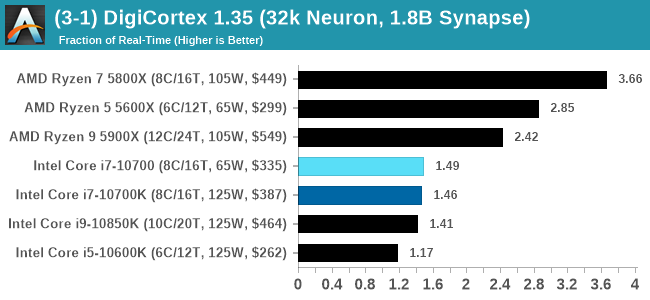
For users wondering why the 5800X wins, it seems that Digicortex prefers single chiplet designs, and the more cores the better. On the Intel side, the 10700 pulls a slight lead.
Dwarf Fortress 0.44.12: Link
Another long standing request for our benchmark suite has been Dwarf Fortress, a popular management/roguelike indie video game, first launched in 2006 and still being regularly updated today, aiming for a Steam launch sometime in the future.
Emulating the ASCII interfaces of old, this title is a rather complex beast, which can generate environments subject to millennia of rule, famous faces, peasants, and key historical figures and events. The further you get into the game, depending on the size of the world, the slower it becomes as it has to simulate more famous people, more world events, and the natural way that humanoid creatures take over an environment. Like some kind of virus.
For our test we’re using DFMark. DFMark is a benchmark built by vorsgren on the Bay12Forums that gives two different modes built on DFHack: world generation and embark. These tests can be configured, but range anywhere from 3 minutes to several hours. After analyzing the test, we ended up going for three different world generation sizes:
- Small, a 65x65 world with 250 years, 10 civilizations and 4 megabeasts
- Medium, a 127x127 world with 550 years, 10 civilizations and 4 megabeasts
- Large, a 257x257 world with 550 years, 40 civilizations and 10 megabeasts
DFMark outputs the time to run any given test, so this is what we use for the output. We loop the small test for as many times possible in 10 minutes, the medium test for as many times in 30 minutes, and the large test for as many times in an hour.
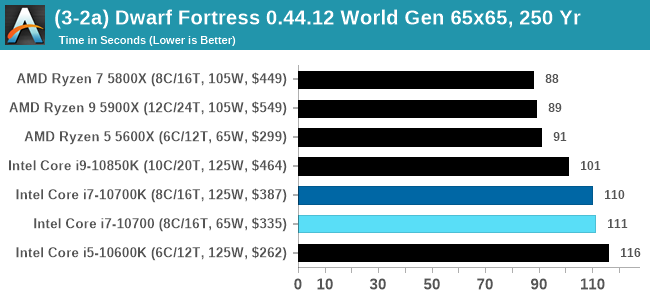
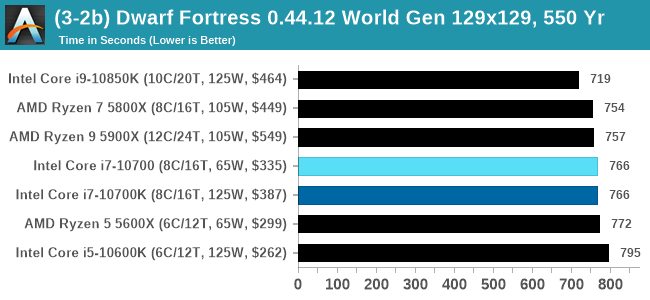
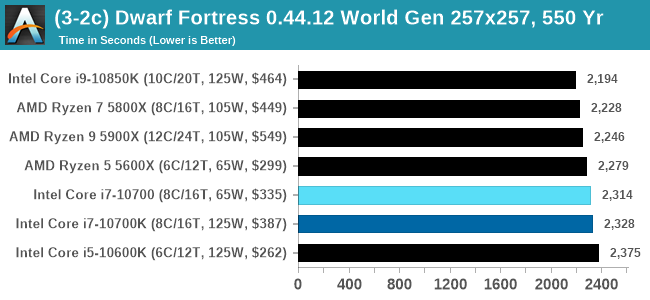
Dolphin v5.0 Emulation: Link
Many emulators are often bound by single thread CPU performance, and general reports tended to suggest that Haswell provided a significant boost to emulator performance. This benchmark runs a Wii program that ray traces a complex 3D scene inside the Dolphin Wii emulator. Performance on this benchmark is a good proxy of the speed of Dolphin CPU emulation, which is an intensive single core task using most aspects of a CPU. Results are given in seconds, where the Wii itself scores 1051 seconds.
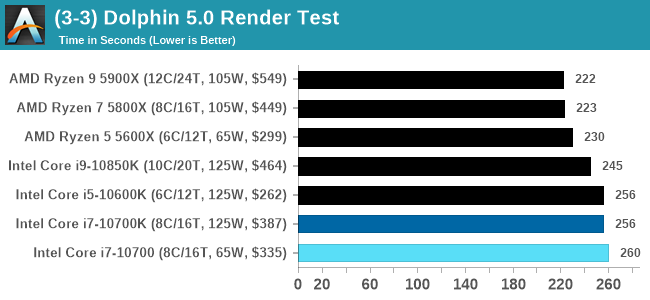












210 Comments
View All Comments
quiq - Sunday, January 24, 2021 - link
I would have liked them to test the processors in addition to the heatsink that comes in the retail box, that would provide a sample of how the product behaves that an end user obtains when buying it. Obviously the use of a heatsink from a 3rd party manufacturer improves the performance of both due to the superior ability to eliminate heat, which helps to maintain the turbo frequencies for longer in both processors.olde94 - Monday, January 25, 2021 - link
one thing i don't see is that the CPU is officially rated 2.9ghz. Not 4.0 as the graphs seems to suggest. We are getting 4.0 with propper cooling, but what i gave it a 90W cooler? Would i end up back at 2.9ghz? We all know that frequency and powerdraw is never a linear curve so we might see 25% lower powerformance at 1/3 the power draw and as such their claim about 65w could be true, but that it peaks if allowed to. I mean don't get me wrong, it's shitty, but is it really that wrong though?noxplague - Monday, January 25, 2021 - link
Dr. Cuttess, thank you as always for these in-depth analyses.I would really like to see how this compares with the previous 9th generation Intel parts (9900, 9700, 9600, etc). However in your bench tool the 2020 and 2019 tests make this difficult. Couldn’t the data be back ported or forward ported and just put N\A for tests that aren’t in both datasets?
I love then bench tool, but it’s recently hamstrung by not allowing for comparisons of 8th gen and 9th gen (and equivalent AMD parts)
Nesteros - Wednesday, January 27, 2021 - link
I was under the impression that TDP was the maximum amount of thermal energy, measured in watts, that a CPU would ever produce and would need to be “removed” by the thermal solution, not the amount of energy measured in watts that a CPU consumes. Surely a processor is not converting all of the power it consumes into heat, else it would be a very efficient space heater and not a CPU.Qasar - Thursday, January 28, 2021 - link
take a look at this :https://www.anandtech.com/show/13544/why-intel-pro...
simply put, intel bases its TDP at BASE clocks, with what they would consider default settings. AMD, bases its TDP, on, for the most part, max power draw. same value, WAY different view of what TDP is between them
Peter-fra - Saturday, February 13, 2021 - link
Dear Anandtech team, thanks a lot for this great clarification of the difference between K and non K Intel products. However, I would like to know what you think about these Geekbench multi-score results showing a gap of around 13% between the 10700 and 10700k on multi-core bench ?=> https://browser.geekbench.com/processor-benchmarks
Since the difference of all core turbo frequency between those 2 processor is around 2-3% (4.7Ghz vs 4.6Ghz) I cannot understand why there would be a 13% gap on this benchmark ?
Does it mean that the Geekbench aggregated data of the 10700 comes from OEM builds with entry level motherboard which doesn't maximize turbo (probably because the VRM are not great) and stay within the intel recommended turbo ?
Scour - Monday, February 15, 2021 - link
That´s the end of my 350W-PSUs :(stealth-katana - Friday, April 2, 2021 - link
The image with the text written with a sharpie on the CPU is making me cringe. 🤣briantim - Wednesday, September 8, 2021 - link
http://home.anandtech.com/show/16343/intel-core-i7...